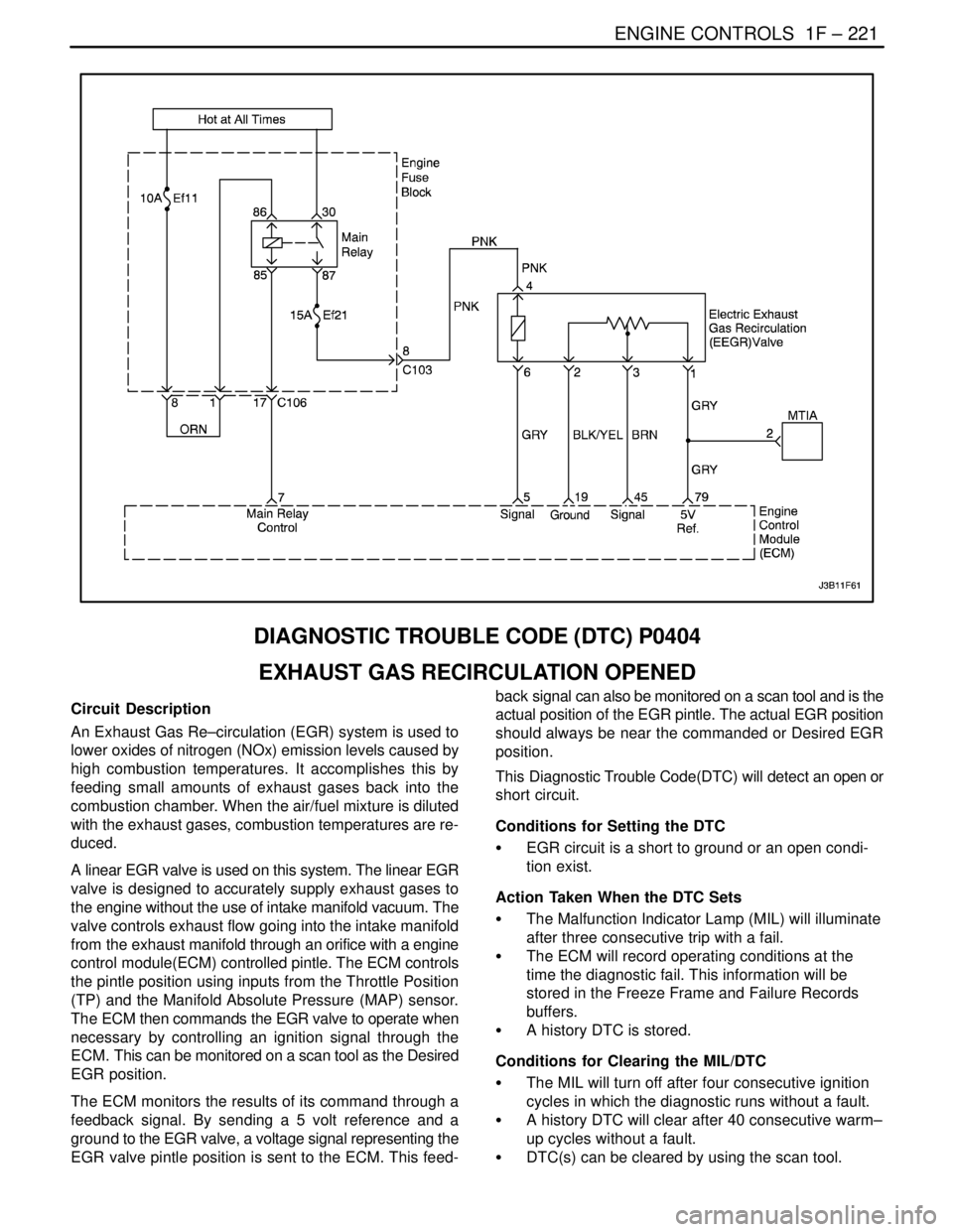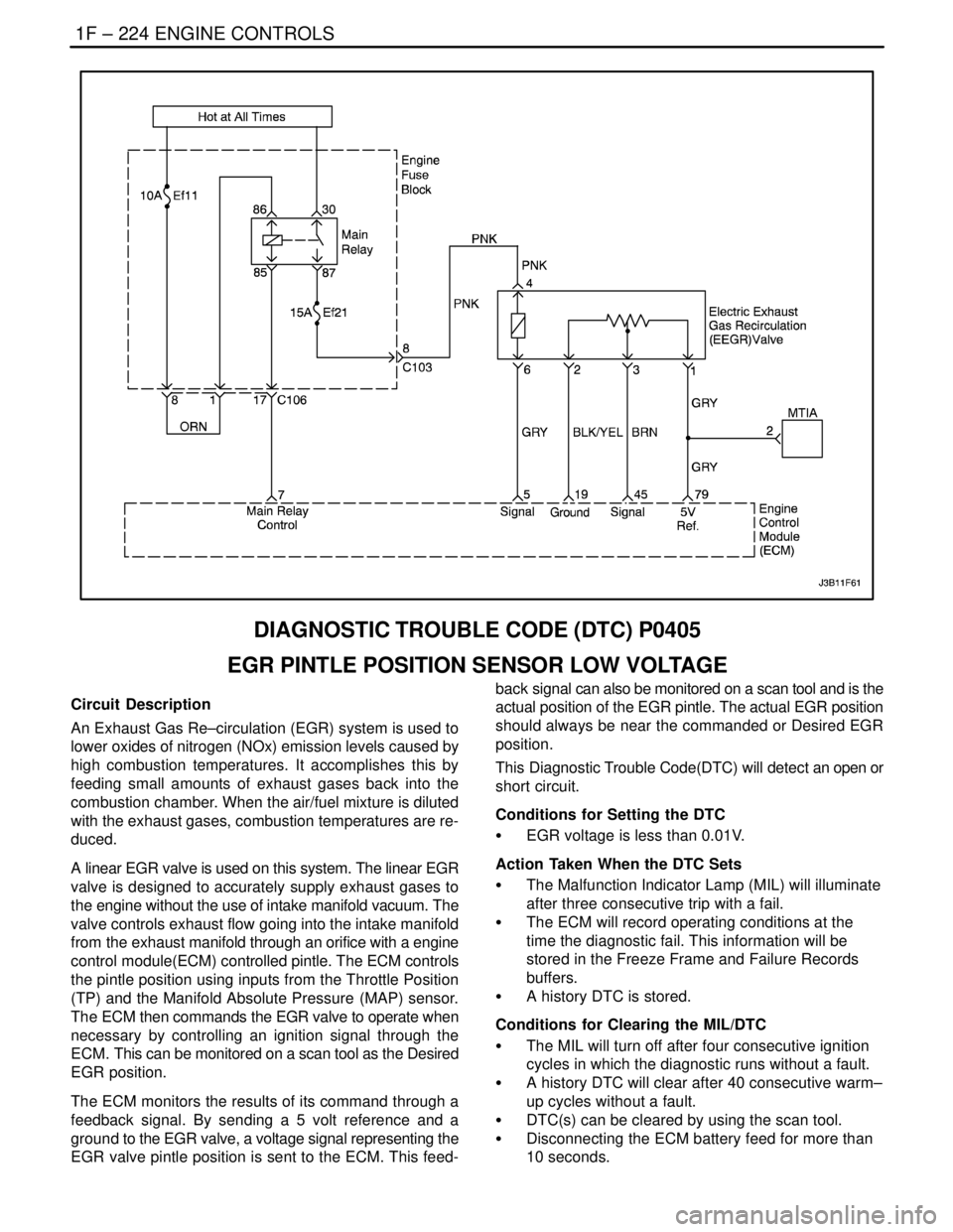2004 DAEWOO LACETTI Map sensor
[x] Cancel search: Map sensorPage 405 of 2643

ENGINE CONTROLS 1F – 159
DAEWOO V–121 BL4
DTC P0171 – Fuel Trim System Too Lean
StepActionValue(s)YesNo
1Perform an Euro On–Board Diagnostic (EOBD)
System Check.
Is the system check complete?–Go to Step 2Go to
”On–Board
Diagnostic Sys-
tem Check”
21. Install the scan tool to the Data Link Connector
(DLC).
2. Turn the ignition ON.
Are any component related Diagnostic Trouble
Codes (DTCs) set?–Go to
applicable DTC
tableGo to Step 3
3With the engine running, operate the vehicle until the
LOOP STATUS indicates closed.
Is the Long Term Fuel Trim value below the specified
value?27%Go to Step 4Go to Step 5
41. Turn the ignition switch ON, with the engine
OFF.
2. Review the Freeze Frame data and note the
parameters.
3. Operate the vehicle within the Freeze Frame
conditions and Conditions for Setting The DTC
as noted.
Does the Long Term Fuel Trim value go below the
specified value while operating under the specified
conditions?27%Go to Step 16Go to Step 5
5Visually/physically check the following items:
S Vacuum hoses for splits, kinks and improper
connections.
S Crankcase ventilation oil/air separator for prop-
er installation.
S Exhaust system for corrosion, leaks, loose or
missing hardware.
S Oxygen sensor (O2S) is installed securely and
the pigtail harness is not contacting exhaust
manifold or engine.
S Fuel for excessive water, alcohol, or other con-
taminants.
S Engine Control Module (ECM) and sensor
grounds are clean, tight, and in their proper
locations.
Do any of the above checks isolate a condition re-
quiring repair?–Go to Step 7Go to Step 6
61. Disconnect the Manifold Absolute Pressure
(MAP) sensor electrical connector.
2. Operate the vehicle in Closed Loop while moni-
toring the Long Term Fuel Trim value.
Is the Long Term Fuel Trim value below the specified
value?27%Go to Step 15Go to Step 9
71. Repair the malfunction found in Step 5.
2. Recheck the Long Term Fuel Trim value while
operating the engine.
Is the Long Term Fuel Trim value below the specified
value?27%Go to Step 8Go to Step 9
Page 406 of 2643

1F – 160IENGINE CONTROLS
DAEWOO V–121 BL4
StepNo Yes Value(s) Action
8Lean condition is not present.
Does a driveability problem exist?–Go to
”Symptom
Diagnosis”Go to Step 16
91. Visually/physically inspect the following items
for vacuum leaks:
S Intake manifold.
S Throttle body.
S Injector O–rings.
2. Repair any leaks found as necessary.
Is the repair complete?–Go to Step 16Go to Step 16
10Allow the engine to idle.
Are the Idle Air Control (IAC) counts above the spe-
cified value?5Go to Step 11Go to Step 12
11Check the fuel for excessive water, alcohol, or other
contaminants and correct the contaminated fuel
condition if present.
Is the repair complete?–Go to Step 16Go to Step 13
12Check the IAC valve performance. Refer to ”DTC
P0506 Idle Speed RPM Lower Than Desired Idle
Speed” or ”DTC P0507 Idle Speed RPM Higher
Than Desired Idle Speed” in this section and repair
as necessary.
Is the repair complete?–Go to Step 16Go to Step 13
131. Connect a fuel pressure gauge to the fuel sys-
tem.
2. Turn the ignition OFF for at least 10 seconds.
3. Turn the ignition ON, with the engine OFF. The
fuel pump will run for approximately 2–3 sec-
onds. It may be necessary to cycle the ignition
switch ON more than once to obtain maximum
fuel pressure.
4. Note the fuel pressure with the fuel pump run-
ning. The pressure should be within the speci-
fied value. When the fuel pump stops, the pres-
sure may vary slightly then hold steady.
Is the fuel pressure steady and does the fuel pres-
sure hold?241–276 kPa
(35–40 psi)Go to Step 14Go to
”Fuel System
Diagnosis”
141. Start and idle the engine at normal operating
temperature.
2. The fuel pressure noted in the above step
should drop by the indicated value.
Does the fuel pressure drop by the indicated value?21–69 kPa
(3–10 psi)Go to
”Fuel Injector
Balance Test”Go to
”Fuel System
Diagnosis”
15Replace the MAP sensor.
Is the action complete?–Go to Step 16–
Page 408 of 2643

1F – 162IENGINE CONTROLS
DAEWOO V–121 BL4
DIAGNOSTIC TROUBLE CODE (DTC) P0172
FUEL TRIM SYSTEM TOO RICH
System Description
If the adaptation value threshold is permanently exceed-
ed, the deviation of the adaptive terms enables to detect
a slow default coming out. Two time counters (one for the
rich side and another one for the lean side) are increased
while the lambda controller exceeds the adaptation
thresholds. As soon as one of the time counters reaches
its maximum value, the error is detected.The aim of this
test is to simulate a failure that would result in exceeding
the adaptive terms. Two kinds of failure must be created.
S A lean side deviation: P0171
S A rich side deviation : P0172
It is thus necessary to determine, for each kind of failure,
the limit good and the limit bad. For a given failure, mea-
sure the emission threshold until the legal emission
thresholds are exceeded.Note that the problem is due to
the emission thresholds required, it is not simple to disturb
the system so that the emission thresholds will be exceed-
ed. The tuning has been made thanks to a dedicated cal-
ibration but, as such a procedure is not permitted by the
regulation, it is necessary to create some material mal-
function (fuel pressure regulator, fuel injector, air leak-
age...).
Conditions for Setting the DTC
S DTCs P0107, P0108, P0112, P0113, P0117,
P0118, P0122, P0123, P0131, P0132, P0337,
P0338, P0341, P0342, P0400, P1319, P1402,
P1404, P1405, P1671 and P1672 are not set.
S Coolant temperature is greater than 20°C (68°F).
(1.4L DOHC)
S Coolant temperature is greater than 80°C (176°F).
(1.6L DOHC)
S Manifold Absolute Pressure (MAP) is greater than
70 kPa (10.2 psi).
S System is in closed loop.
Action Taken When the DTC SetsS The Malfunction Indicator Lamp (MIL) will illuminate
after three consecutive trip with a fail.
S The ECM will record operating conditions at the
time the diagnostic fail. This information will be
stored in the Freeze Frame and Failure Records
buffers.
S A history DTC is stored.
Conditions for Clearing the MIL/DTC
S The MIL will turn off after four consecutive ignition
cycles in which the diagnostic runs without a fault.
S A history DTC will clear after 40 consecutive warm
up cycles without a fault.
S DTC(s) can be cleared by using the scan tool.
S Disconnecting the ECM battery feed for 10 sec-
onds.
Diagnostic Aids
Important : After repairs, use the scan tool Fuel Trim Re-
set function to reset the long–term fuel trim to 128 (0%).
Check for poor connection at the ECM. Inspect the har-
ness connectors for the following conditions:
S Backed–out terminals.
S Improper mating.
S Broken locks.
S Improperly formed.
S Damaged terminals.
S Poor terminal–to–wire connection.
Inspect the wiring harness for damage. If the harness ap-
pears to be OK, observe the O2S display on the scan tool
while moving the connectors and the wiring harness re-
lated to the engine harness. A change in the display will
indicate the location of the fault.
If a DTC P1404 is also set, check the 5 volt reference cir-
cuits for a short to voltage.
Check for a restricted exhaust system.
A shorted 5 volt reference circuit may cause a DTC P0172
to set. Check the 5 volt reference sensors for abnormal
readings.
DTC P0172 – Fuel Trim System Too Rich
StepActionValue(s)YesNo
1Perform an Euro On–Board Diagnostic (EOBD)
System Check.
Is the system check complete?–Go to Step 2Go to
”On–Board
Diagnostic Sys-
tem Check”
21. Install the scan tool to the Data Link Connector
(DLC).
2. Turn the ignition ON.
Are any component related Diagnostic Trouble
Codes (DTCs) set?–Go to
applicable DTC
tableGo to Step 3
Page 409 of 2643

ENGINE CONTROLS 1F – 163
DAEWOO V–121 BL4
StepNo Yes Value(s) Action
3With the engine running, operate the vehicle until the
LOOP STATUS indicates closed.
Is the Long Term Fuel Trim value above the specified
value?–30%Go to Step 4Go to Step 5
41. Turn the ignition switch ON, with the engine
OFF.
2. Review the Freeze Frame data and note the
parameters.
3. Operate the vehicle within the Freeze Frame
conditions and Conditions for Setting The DTC
as noted.
Does the Long Term Fuel Trim value above the spe-
cified value while operating under the specified con-
ditions?–30%Go to Step 21Go to Step 5
5Visually/physically check the air cleaner filter for ex-
cessive dirt or being plugged and repair as needed.
Is the repair complete?–Go to Step 21Go to Step 6
6Visually/physically check the air intake system for
collapsed or restricted and repair as needed.
Is the repair complete?–Go to Step 21Go to Step 7
7Inspect the throttle body inlet for damaged or foreign
objects which may partially block the airflow and re-
pair as needed.
Is the repair complete?–Go to Step 21Go to Step 8
81. Turn the ignition OFF.
2. Inspect the throttle bore, throttle plate and Idle
Air Control (IAC) passages for clocking and
foreign objects and repair as needed.
Is the repair complete?–Go to Step 21Go to Step 9
9Start the engine with the vehicle in park or neutral
and A/C off and note the idle quality.
Is a low or unsteady idle being experienced?–Go to Step 10Go to Step 12
10Idle the engine.
Are the IAC counts below the specified value?100Go to Step 12Go to Step 11
111. Turn the ignition OFF.
2. Disconnect the Manifold Absolute Pressure
(MAP) sensor electrical connector.
3. Start the engine.
4. Operate the vehicle in Closed Loop while moni-
toring the Long Term Fuel Trim value.
Does the Long Term Fuel Trim value increase above
the specified value?–30%Go to Step 20Go to Step 12
12Check the IAC valve performance. Refer to ”DTC
P0506 Idle Speed RPM Lower Than Desired Idle
Speed” or ”DTC P0507 Idle Speed RPM Higher
Than Desired Idle Speed” in this section and repair
as necessary.
Is the repair complete?–Go to Step 21Go to Step 13
Page 410 of 2643

1F – 164IENGINE CONTROLS
DAEWOO V–121 BL4
StepNo Yes Value(s) Action
131. Disconnect the vacuum hose from the fuel
pressure regulator and inspect the hose for the
presence of fuel.
2. If fuel is presence in the vacuum hose, replace
the fuel pressure regulator.
Is the repair complete?–Go to Step 21Go to Step 14
141. Turn the ignition ON.
2. Slowly press the acceleration pedal.
Does the Throttle Position (TP) sensor display in-
crease steady and evenly from its minimum voltage
at closed throttle to its maximum voltage at Wide–
Open Throttle (WOT).–Go to Step 15Go to Step 19
151. Perform the Fuel System Diagnosis.
2. If the table isolate a problem, repair as needed.
Is the repair complete?–Go to Step 21Go to Step 16
161. Perform the Evaporative Emission (EVAP)
Control System Diagnosis.
2. If the table isolate a problem, repair as needed.
Is the repair complete?–Go to Step 21Go to Step 17
171. Perform the Fuel Injector Balance Test.
2. If the table isolate a problem, repair as needed.
Is the repair complete?–Go to Step 21Go to Step 18
181. Remove the Oxygen Sensor (O2S).
2. Visually/physically inspect the O2S for silicone
contamination.
3. Note: this will be indicated by a powdery white
deposit on the portion of the O2S exposed to
the exhaust stream.
4. If contamination is present on the O2S, find the
source and repair as needed.
Is the repair complete?–Go to Step 21Go to
”Diagnostic
Aids”
191. Check the TP sensor mounting screws.
2. If they are too loose or missing tighten or re-
place them as needed.
3. If the screws are OK, replace the TP sensor.
Is the repair complete?–Go to Step 21–
201. Turn the ignition OFF.
2. Replace the MAP sensor.
Is the repair complete?–Go to Step 21–
211. Using the scan tool, clear the Diagnostic
Trouble Codes (DTCs).
2. Start the engine and idle at normal operating
temperature.
3. Operate the vehicle within the Conditions for
setting this DTC as specified in the supporting
text.
Does the scan tool indicate that this diagnostic has
run and passed?–Go to Step 21Go to Step 2
22Check if any additional DTCs are set.
Are any DTCs displayed that have not been diag-
nosed?–Go to
applicable DTC
tableSystem OK
Page 464 of 2643

1F – 218IENGINE CONTROLS
DAEWOO V–121 BL4
DIAGNOSTIC TROUBLE CODE (DTC) P0400
EXHAUST GAS RECIRCULATION OUT OF LIMIT
Circuit Description
An Exhaust Gas Re–circulation (EGR) system is used to
lower oxides of nitrogen (NOx) emission levels caused by
high combustion temperatures. It accomplishes this by
feeding small amounts of exhaust gases back into the
combustion chamber. When the air/fuel mixture is diluted
with the exhaust gases, combustion temperatures are re-
duced.
A linear EGR valve is used on this system. The linear EGR
valve is designed to accurately supply exhaust gases to
the engine without the use of intake manifold vacuum. The
valve controls exhaust flow going into the intake manifold
from the exhaust manifold through an orifice with a engine
control module(ECM) controlled pintle. The ECM controls
the pintle position using inputs from the Throttle Position
(TP) and the Manifold Absolute Pressure (MAP) sensor.
The ECM then commands the EGR valve to operate when
necessary by controlling an ignition signal through the
ECM. This can be monitored on a scan tool as the Desired
EGR position.
The ECM monitors the results of its command through a
feedback signal. By sending a 5 volt reference and a
ground to the EGR valve, a voltage signal representing the
EGR valve pintle position is sent to the ECM. This feed-back signal can also be monitored on a scan tool and is the
actual position of the EGR pintle. The actual EGR position
should always be near the commanded or Desired EGR
position.
This Diagnostic Trouble Code(DTC) will detect an open or
short circuit.
Conditions for Setting the DTC
S The vehicle is part load.
S The engine controls system is in closed loop.
S Engine Coolant Temperature (ECT) is higher than
70°C (158°F). (1.4L DOHC)
S Engine Coolant Temperature (ECT) is higher than
60°C (140°F). (1.6L DOHC)
S Mass Air Flow is between 120~230mg/tdc.
(1.4L DOHC)
S Mass Air Flow is between 71~174mg/tdc.
(1.6L DOHC)
S Engine Speed is Between 1,800~2,400rpm.
(1.4L DOHC)
S Engine Speed is Between 1,950~2,600rpm.
(1.6L DOHC)
S Intake Air Temperature(IAT) is higher than
15°C(59°F).
S Manifold Absolute Pressure is greater than 75kPA.
S The EGR is higher than 10%.
Page 467 of 2643

ENGINE CONTROLS 1F – 221
DAEWOO V–121 BL4
DIAGNOSTIC TROUBLE CODE (DTC) P0404
EXHAUST GAS RECIRCULATION OPENED
Circuit Description
An Exhaust Gas Re–circulation (EGR) system is used to
lower oxides of nitrogen (NOx) emission levels caused by
high combustion temperatures. It accomplishes this by
feeding small amounts of exhaust gases back into the
combustion chamber. When the air/fuel mixture is diluted
with the exhaust gases, combustion temperatures are re-
duced.
A linear EGR valve is used on this system. The linear EGR
valve is designed to accurately supply exhaust gases to
the engine without the use of intake manifold vacuum. The
valve controls exhaust flow going into the intake manifold
from the exhaust manifold through an orifice with a engine
control module(ECM) controlled pintle. The ECM controls
the pintle position using inputs from the Throttle Position
(TP) and the Manifold Absolute Pressure (MAP) sensor.
The ECM then commands the EGR valve to operate when
necessary by controlling an ignition signal through the
ECM. This can be monitored on a scan tool as the Desired
EGR position.
The ECM monitors the results of its command through a
feedback signal. By sending a 5 volt reference and a
ground to the EGR valve, a voltage signal representing the
EGR valve pintle position is sent to the ECM. This feed-back signal can also be monitored on a scan tool and is the
actual position of the EGR pintle. The actual EGR position
should always be near the commanded or Desired EGR
position.
This Diagnostic Trouble Code(DTC) will detect an open or
short circuit.
Conditions for Setting the DTC
S EGR circuit is a short to ground or an open condi-
tion exist.
Action Taken When the DTC Sets
S The Malfunction Indicator Lamp (MIL) will illuminate
after three consecutive trip with a fail.
S The ECM will record operating conditions at the
time the diagnostic fail. This information will be
stored in the Freeze Frame and Failure Records
buffers.
S A history DTC is stored.
Conditions for Clearing the MIL/DTC
S The MIL will turn off after four consecutive ignition
cycles in which the diagnostic runs without a fault.
S A history DTC will clear after 40 consecutive warm–
up cycles without a fault.
S DTC(s) can be cleared by using the scan tool.
Page 470 of 2643

1F – 224IENGINE CONTROLS
DAEWOO V–121 BL4
DIAGNOSTIC TROUBLE CODE (DTC) P0405
EGR PINTLE POSITION SENSOR LOW VOLTAGE
Circuit Description
An Exhaust Gas Re–circulation (EGR) system is used to
lower oxides of nitrogen (NOx) emission levels caused by
high combustion temperatures. It accomplishes this by
feeding small amounts of exhaust gases back into the
combustion chamber. When the air/fuel mixture is diluted
with the exhaust gases, combustion temperatures are re-
duced.
A linear EGR valve is used on this system. The linear EGR
valve is designed to accurately supply exhaust gases to
the engine without the use of intake manifold vacuum. The
valve controls exhaust flow going into the intake manifold
from the exhaust manifold through an orifice with a engine
control module(ECM) controlled pintle. The ECM controls
the pintle position using inputs from the Throttle Position
(TP) and the Manifold Absolute Pressure (MAP) sensor.
The ECM then commands the EGR valve to operate when
necessary by controlling an ignition signal through the
ECM. This can be monitored on a scan tool as the Desired
EGR position.
The ECM monitors the results of its command through a
feedback signal. By sending a 5 volt reference and a
ground to the EGR valve, a voltage signal representing the
EGR valve pintle position is sent to the ECM. This feed-back signal can also be monitored on a scan tool and is the
actual position of the EGR pintle. The actual EGR position
should always be near the commanded or Desired EGR
position.
This Diagnostic Trouble Code(DTC) will detect an open or
short circuit.
Conditions for Setting the DTC
S EGR voltage is less than 0.01V.
Action Taken When the DTC Sets
S The Malfunction Indicator Lamp (MIL) will illuminate
after three consecutive trip with a fail.
S The ECM will record operating conditions at the
time the diagnostic fail. This information will be
stored in the Freeze Frame and Failure Records
buffers.
S A history DTC is stored.
Conditions for Clearing the MIL/DTC
S The MIL will turn off after four consecutive ignition
cycles in which the diagnostic runs without a fault.
S A history DTC will clear after 40 consecutive warm–
up cycles without a fault.
S DTC(s) can be cleared by using the scan tool.
S Disconnecting the ECM battery feed for more than
10 seconds.